|
There are so many kinds of beads but I am going to start with the beads
that I use most often and in most quantity in my work. Seed beads come in an amazing variety
of sizes and even a few variations in shape. the name comes from the fact that early seed beads
were meant to be used in place of seed pearls for embroideries and the like.
Like the seeds we plant in the ground, however, these tiny jewels now come in a wide variety of sizes.
When these marvels are woven or strung together they can form the most beautiful
of treasured keepsakes.
Seed Beads
- Taiwanese, Chinese, and Indian
 These beads have the least amount of uniformity of size or shape. Thus they are not
good choices for loom work or for geometric or other very precise designs in peyote, brick or
square stitches. They are, however, superb for free-form beadwork both weavings and bead
embroidery. They give handmade beadwork a wild chaotic flare. These are the beads most often
encountered in hobby and craft chain stores.
These beads have the least amount of uniformity of size or shape. Thus they are not
good choices for loom work or for geometric or other very precise designs in peyote, brick or
square stitches. They are, however, superb for free-form beadwork both weavings and bead
embroidery. They give handmade beadwork a wild chaotic flare. These are the beads most often
encountered in hobby and craft chain stores.
- Czech
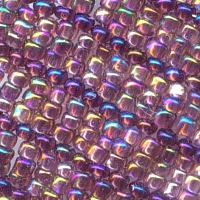 For a long time these amazing little pieces of glass art were the pinnacle of uniformity of
size and shape. They are best used for circular peyote, brickstitch, right-angle weave, netting,
bead embroidery and free-form beadweaving. One must be on the alert for small size discrepancies,
but these do not detract from the creation of many beautiful works. These seed beads come in the most myriad
array of colors, finishes and sizes. They are the handmade work of small family factories still producing in
the Czech Republic.
For a long time these amazing little pieces of glass art were the pinnacle of uniformity of
size and shape. They are best used for circular peyote, brickstitch, right-angle weave, netting,
bead embroidery and free-form beadweaving. One must be on the alert for small size discrepancies,
but these do not detract from the creation of many beautiful works. These seed beads come in the most myriad
array of colors, finishes and sizes. They are the handmade work of small family factories still producing in
the Czech Republic.
- Italian and French
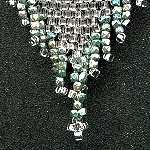 Some of the oldest sizes, colors and finishes were and occasionally still are made in France and Venice.
The vintage beads, such as the fringe beads shown in the image at left, especially add a certain panache unavailable from other, more modern, types of seed beads.
These are often very tiny and delicate, usually glass but occasionally metal beads with facets and delicately
dyed finishes can be found. These are wonderful for delicate but ornate embroideries on silk and velvet, and
are superlative flowing accents to any beading project.
Some of the oldest sizes, colors and finishes were and occasionally still are made in France and Venice.
The vintage beads, such as the fringe beads shown in the image at left, especially add a certain panache unavailable from other, more modern, types of seed beads.
These are often very tiny and delicate, usually glass but occasionally metal beads with facets and delicately
dyed finishes can be found. These are wonderful for delicate but ornate embroideries on silk and velvet, and
are superlative flowing accents to any beading project.
- Japanese
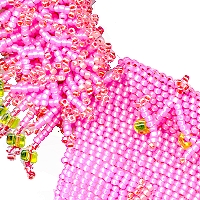 The Japanese seed bead industry is mostly something of a latecomer but what they lack in ancient history is
more than balanced by the high quality of their products. Not only do they have the more traditional
rounded seed beads, but also tiny perfect cylindrical beads, the most famous of which are the Delicas made by
the Miyuki company. Delicas are particularily well suited for highly geometrical and precise patterns in peyote
and brickstitch as well as loom work. They are not well suited for free-form stitches or circular weavings
such as circular peyote and right-angle weave. As with the Czech beads, the colors are distinct and different
and quite different. I, myself, prefer the rounded beads for their fluidity and versitility of form even when my
design includes a geometrical component. The Japaese companies are known for their use of computers create their
incredibly uniform beads. They are also able to create smaller beads with larger holes than other manufacturors which
is a very good thing when a weave calls for lots of passes!
The Japanese seed bead industry is mostly something of a latecomer but what they lack in ancient history is
more than balanced by the high quality of their products. Not only do they have the more traditional
rounded seed beads, but also tiny perfect cylindrical beads, the most famous of which are the Delicas made by
the Miyuki company. Delicas are particularily well suited for highly geometrical and precise patterns in peyote
and brickstitch as well as loom work. They are not well suited for free-form stitches or circular weavings
such as circular peyote and right-angle weave. As with the Czech beads, the colors are distinct and different
and quite different. I, myself, prefer the rounded beads for their fluidity and versitility of form even when my
design includes a geometrical component. The Japaese companies are known for their use of computers create their
incredibly uniform beads. They are also able to create smaller beads with larger holes than other manufacturors which
is a very good thing when a weave calls for lots of passes!
Seed Bead Cousins
- Bugle Beads
Bugle beads are long thin tubes of glass. They vary in size from 3 mm to 25 and even 30+ mm! They can be smooth or twisted and
can have the same colors and finishes as standard seed beads. Both Czech and Japanese manufacturors produce bugle beads to
complement their seed bead styles.
- Triangle Beads
While some Czech studios are producing triangle shaped seed beads, the most prevelent are those from the Japanese
producers. The come in three sizes and add a sort of bubbly texture to woven beadwork.
- Cube Beads
These tend to be larger beads, three and four millimeters in size. Like the triangle beads, their use adds an extra dimension
of textural interest to handmade bead weaving. Of course each bead shape reflects its color and shimmer in a
manner related to their shape that makes all this variety of interest and use to the artist.
- Twisted Hex Beads
These are somewhat related to twisted bugle beads in that like the bugles, they are elongated in shape. They are, however, shorter
than three millimeters as well as definitely hexogonal in shape. This adds yet another alternative for the artist to vary her
bead palette.
If you have any questions or comments, please contact me. I would love to hear from you.
|
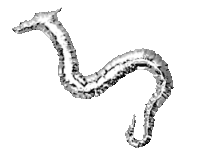
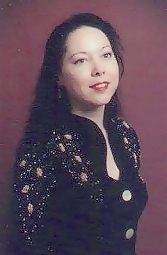


 These beads have the least amount of uniformity of size or shape. Thus they are not
good choices for loom work or for geometric or other very precise designs in peyote, brick or
square stitches. They are, however, superb for free-form beadwork both weavings and bead
embroidery. They give handmade beadwork a wild chaotic flare. These are the beads most often
encountered in hobby and craft chain stores.
These beads have the least amount of uniformity of size or shape. Thus they are not
good choices for loom work or for geometric or other very precise designs in peyote, brick or
square stitches. They are, however, superb for free-form beadwork both weavings and bead
embroidery. They give handmade beadwork a wild chaotic flare. These are the beads most often
encountered in hobby and craft chain stores. For a long time these amazing little pieces of glass art were the pinnacle of uniformity of
size and shape. They are best used for circular peyote, brickstitch, right-angle weave, netting,
bead embroidery and free-form beadweaving. One must be on the alert for small size discrepancies,
but these do not detract from the creation of many beautiful works. These seed beads come in the most myriad
array of colors, finishes and sizes. They are the handmade work of small family factories still producing in
the Czech Republic.
For a long time these amazing little pieces of glass art were the pinnacle of uniformity of
size and shape. They are best used for circular peyote, brickstitch, right-angle weave, netting,
bead embroidery and free-form beadweaving. One must be on the alert for small size discrepancies,
but these do not detract from the creation of many beautiful works. These seed beads come in the most myriad
array of colors, finishes and sizes. They are the handmade work of small family factories still producing in
the Czech Republic. Some of the oldest sizes, colors and finishes were and occasionally still are made in France and Venice.
The vintage beads, such as the fringe beads shown in the image at left, especially add a certain panache unavailable from other, more modern, types of seed beads.
These are often very tiny and delicate, usually glass but occasionally metal beads with facets and delicately
dyed finishes can be found. These are wonderful for delicate but ornate embroideries on silk and velvet, and
are superlative flowing accents to any beading project.
Some of the oldest sizes, colors and finishes were and occasionally still are made in France and Venice.
The vintage beads, such as the fringe beads shown in the image at left, especially add a certain panache unavailable from other, more modern, types of seed beads.
These are often very tiny and delicate, usually glass but occasionally metal beads with facets and delicately
dyed finishes can be found. These are wonderful for delicate but ornate embroideries on silk and velvet, and
are superlative flowing accents to any beading project. The Japanese seed bead industry is mostly something of a latecomer but what they lack in ancient history is
more than balanced by the high quality of their products. Not only do they have the more traditional
rounded seed beads, but also tiny perfect cylindrical beads, the most famous of which are the Delicas made by
the Miyuki company. Delicas are particularily well suited for highly geometrical and precise patterns in peyote
and brickstitch as well as loom work. They are not well suited for free-form stitches or circular weavings
such as circular peyote and right-angle weave. As with the Czech beads, the colors are distinct and different
and quite different. I, myself, prefer the rounded beads for their fluidity and versitility of form even when my
design includes a geometrical component. The Japaese companies are known for their use of computers create their
incredibly uniform beads. They are also able to create smaller beads with larger holes than other manufacturors which
is a very good thing when a weave calls for lots of passes!
The Japanese seed bead industry is mostly something of a latecomer but what they lack in ancient history is
more than balanced by the high quality of their products. Not only do they have the more traditional
rounded seed beads, but also tiny perfect cylindrical beads, the most famous of which are the Delicas made by
the Miyuki company. Delicas are particularily well suited for highly geometrical and precise patterns in peyote
and brickstitch as well as loom work. They are not well suited for free-form stitches or circular weavings
such as circular peyote and right-angle weave. As with the Czech beads, the colors are distinct and different
and quite different. I, myself, prefer the rounded beads for their fluidity and versitility of form even when my
design includes a geometrical component. The Japaese companies are known for their use of computers create their
incredibly uniform beads. They are also able to create smaller beads with larger holes than other manufacturors which
is a very good thing when a weave calls for lots of passes!